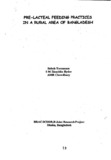| dc.identifier.citation | Tarannum, S., Ziauddin , S. M., & Chowdhury, A. (1997). Pre-lacteal feeding practices in a rural area of Bangladesh. Research Reports (1997): Health Studies, Vol - XXII, 19–40. | en_US |
| dc.description.abstract | This study aims to describe the nature and extent of pre-lacteal fluid and colostrum
feeding practices in a rural community of Bangladesh and also to investigate the mothers
level of knowledge in relation to hygiene and safety related to the feeding practices. The
data were obtained from 473 mothers with infants aged less than 24 months from 14
villages of Matlab thana from April to August 1995. A total of 2076 households were
visited to obtain the above number of the eligible mothers. The households were
categorized into two groups based on their socioeconomic status, i.e., BRAC eligible or
poor and non-eligible or non-poor.
The survey revealed that about 93% of the infants received pre-lacteal liquid and only 7%
received breast milk as the first liquid. Honey or honey with water was the most
frequently given pre-lacteal liquid followed by mustard oil, which they believed, would
clean the baby's mouth. Surprisingly, around 12% of the infants did not receive any
nutritious liquid except for plain water until 24 hours after birth. About 3 5 and 44% of
the mothers in BRAC eligible and non-eligible households respectively mentioned that
giving honey before initiation of breast feeding was their tradition. Among the BRAC
eligible households, 22% of the mothers stated that insufficient milk secretion
immediately after delivery was the reason to give pre-lacteal liquid. A majority of the
mothers stated that finger, in most instances without washing, was used to introduce the
liquid in the baby's mouth. Frequency of finger use was higher among the BRAC eligible
compare to non-eligible households. Grand mothers were the initiators of pre-lacteal
liquid in about 47% instances followed by the birth attendants, 25%. Sixty two percent of
the infants among BRAC eligible and 76% among the non-eligible households received
colostrum. Mothers from both BRAC eligible and non- eligible households seemed to
have adequate knowledge about colostrum feeding in terms of its beneficial effects on
infants' health. They mentioned that colostrum was a nutritious liquid, which provide_d .
required nutrients and protected the babies against infections.
In conclusion, pre-lacteal feeding was highly prevalent in the villages of Matlab thana,
which perhaps a common feature in other rural areas of Bangladesh. In most of the cases,
women's lives, increased income/livelihood security, fertility control, increased
nutritional status, decreased morbidity and decreased mortality (7). Improved nutritional
status was identified as one of the important components of human well-being. | en_US |

